Traditional Japanese culture has been handed down from generation to generation, with each traditional form greatly valued for its historical and cultural values. Among them, 「衣・食・住」 or “clothing / food / shelter” is deeply connected to the Japanese people’s everyday lives.
In this article, we introduce in detail the different Japanese cultures and traditional performing arts. Learn more in advance so that you can enjoy traditional Japanese culture when you come to Japan.
First Published : 2022/12/09
Updated : 2023/07/12
Table of Content
- Japanese Traditional Culture Attracts Global Attention
- Famous Traditional Japanese Culture
- Different Japanese Cultures in Events and Celebrations
- Help Save Traditional Japanese Culture!!
- Experience Different Japanese Cultures when Visiting Japan
Japanese Traditional Culture Attracts Global Attention

Traditional Japanese culture has always, and continues to, attract attention from people around the world. Why? Because it strongly reflects the spirituality, customs and values of the Japanese people. For example, kimonos, dyed goods and ceramics are traditional crafts produced by techniques inherited from long ago.
Another huge attraction of Japan is its traditional Japanese food culture that uses ingredients nurtured in its rich natural environment and encompasses the four seasons. Traditional performing arts such as Kabuki, Noh, and Buyo are also famous in Japan and abroad.
Just like this, as it attracts people near and far, Japanese traditional culture that was formed a long time ago continues to be passed down through generations.
What uniquely Japanese concepts influence the different parts of Japanese culture?
Traditional Japanese culture is heavily influenced by concepts such as Zen and Wabi-sabi.
Zen (禅) is an abbreviation for Zen Buddhism, which came to Japan from China. The aim of Zen is to unify the spirit and create a humane way of life. Zen’s influence on traditional Japanese culture includes martial arts, tea ceremony and calligraphy.
Wabi-sabi (侘び寂び・わびさび) is a term used to describe calm beauty without ostentation (vain and unnecessary extravagance). Wabi-sabi can be observed in traditional Japanese cultures like architecture and gardens, which are designed in a simple manner to exude a sense of grace and charm.
Writer's Pick
Famous Traditional Japanese Culture
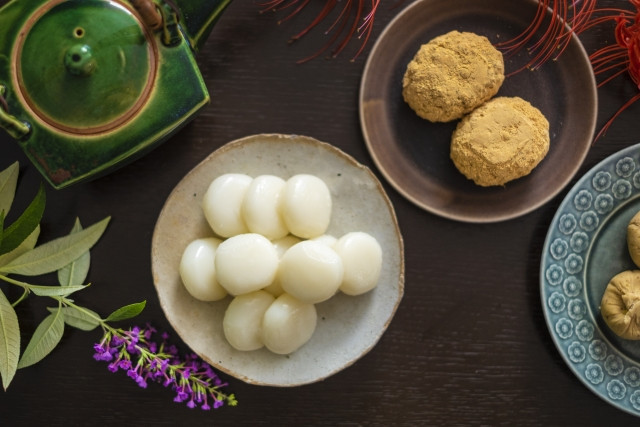
It is no exaggeration to say that “clothing / food / shelter 「衣・食・住」” are the pillars of traditional Japanese culture. This part will deepen understanding of these 3 themes which are closely associated with Japanese life and culture, and are familiar to the Japanese people since ancient times.
Traditional Japanese Clothing: Kimono
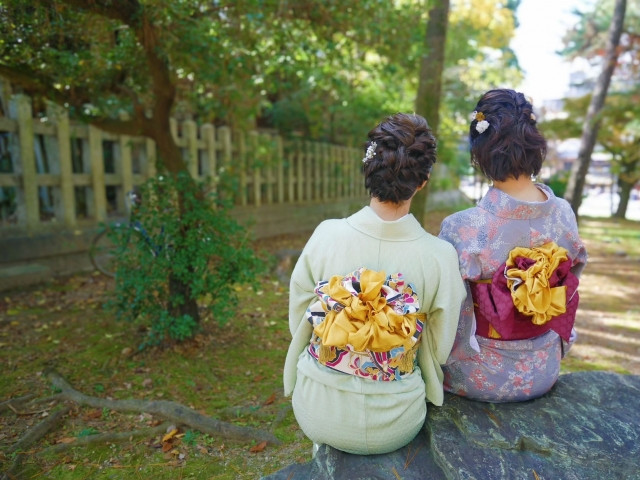
What most people think of when it comes to traditional Japanese “clothing (衣)” is kimono. Kimono is Japan’s national garment. It comes in a variety of colours and the pattern designs are beautiful works of art; the kimono is a symbol of the Japanese sense of beauty.
There are different types of kimono that can be categorised into formal wear, visiting kimono and everyday wear. What type of kimono to wear is decided by the occasion. It is also considered good etiquette to choose the material, pattern, and colour to coincide with the right season.
The prototype garment of the kimono originated in the Heian period, and until the Meiji era with the coming of foreign cultures and influence, was the choice of everyday clothing for Japanese. In recent years, there are fewer opportunities to wear kimonos as everyday wear, but it is customary to wear them as formal wear at festive events such as weddings, coming-of-age ceremonies, and shrine visits.
For more about traditional Japanese clothing, read Traditional Japanese Clothing: Kimono, Yukata, Jinbei, Hakama and more. In the article, we introduce other types of traditional Japanese clothing, the different types of kimono, and go deeper into the history of Japanese traditional clothing.
Traditional Japanese Food: Washoku
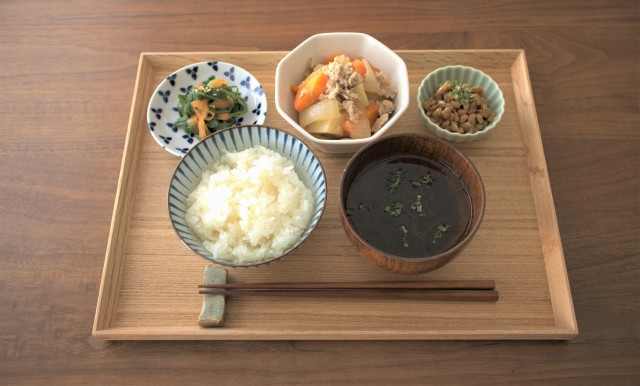
Speaking about traditional Japanese “food (食)”, the most famous is surely Washoku (和食). Washoku is born of the culinary culture to make the most use of natural resources from the land and sea as Japan has many mountains and is surrounded by ocean. Naturally, the image of the four seasons, also part of nature, is a great influence and inspiration on Japan’s culinary scene as well.
Since times of old, the Japanese have always respected and valued nature and its spirits, and are grateful for its bounty. As a result, Japanese cooking methods tend to use ingredients without waste, and there is particular emphasis on where and how meals are eaten.
Washoku cuisine contains a 5th flavour called “umami (うま味)”. Umami is produced when sodium and potassium from ingredients like dried bonito flakes, konbu (kelp), and dired shiitake mushrooms combine. Washoku is characterised by delicate flavours that maximise the flavours of the ingredients using umami, salt, miso, and soy sauce.
Many of the seasonings used in Washoku are fermented, which are said to reduce the intake of animal fats and oils, and thus effective in preventing obesity and good for longevity. In addition, Washoku is a healthy and nutritionally balanced meal, with the basic form of Washoku following the concept of “1 soup 3 vegetables”.
Our A Close Look at Japanese Traditional Food, Washoku: Features & Dishes will help you learn more about Washoku. Read to find out more about Washoku’s characteristics, examples of Washoku dishes, and Japanese traditional sweets Wagashi.
Traditional Japanese Architecture

For “shelter (住)”, we have traditional Japanese architecture that is world famous. Japan is a country with many forests and therefore many trees and wood as building materials, which is why wooden buildings have been constructed there since olden times. The high temperature and humidity characteristic of Japan’s climate produces great timber with excellent water resistance and permeability, an ideal choice for many wooden buildings.
Another feature of Japanese architecture is the use of tatami (畳), made of grass (草), as flooring. Tatami is flooring material with excellent air permeability and is well suited to the Japanese climate.
There are many old wooden buildings in Japan, including Horyu-Ji (法隆寺), the world’s oldest wooden building that was built in the Asuka period. The method of construction for wooden buildings changes through time, gradually improving along with the advancement of construction techniques. The carpenters who specialise in building shrines and temples are called “miyadaiku (宮大工)”. They are highly skilled in woodworking, and can construct buildings without a single nail.
The Horyu-Ji with a central pillar called “shinbashira (心柱; central pillar of a pagoda)" allows each floor to be build independently. This is done so that whenever an earthquake occurs, the vibrations can escape and prevent the building from collapsing. Japan is earthquake-prone so seismic damping and other earthquake prevention measures need to be incorporated when constructing buildings, which is why traditional wooden structures that can withstand earthquakes still exist to this day.
Are you interested in visiting Japanese temples and shrines? Our article Visiting Places Representative of Japan’s Shrines and Temples introduces the shrines and temples that are a must-visit in Japan.
Japanese Gardens: Nihon Teien
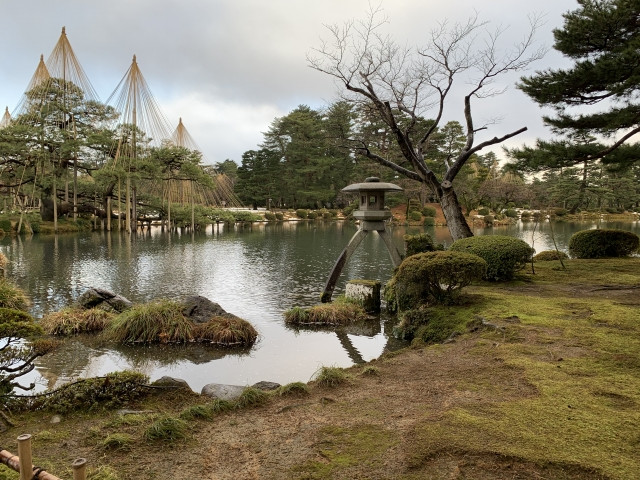
Japanese Gardens (日本庭園 nihon teien), part of traditional Japanese cultures, are created in a variety of styles. Most Japanese gardens are in the “tsukiyama (築山)” style in which the centrepiece is a pond, and there are artificial mountains called tsukiyama created by piling up stones, earth and sand to recreate a natural scenery.
There are also Japanese gardens called “karesansui (枯山水)”, which uses only rocks and sand to express the flow of water. There are various styles of karesansui, or dry landscape, gardens.
There are 3 beautiful Japanese gardens in Japan known collectively as “The Three Great Gardens of Japan “日本三名庭園”. They are:
-
Kenrokuen Garden in Kanazawa City, Ishikawa Prefecture
-
Korakuen Garden in Okayama City, Okayama Prefecture
-
Kairakuen Garden in Mito City, Ibaraki Prefecture
Do pay them a visit when you come to Japan.
Haiku (Japanese Poetry)
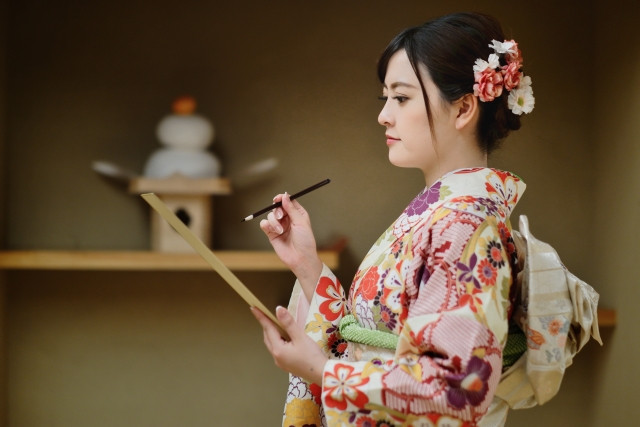
Haiku (俳句) is a short poem consisting of 17 syllables in a "5-7-5" pattern. It is popular among a wide range of people, from elderly to children, as a part of traditional Japanese culture.
Haiku is characterised by the inclusion of a “seasonal word (季語 kigo)” that represents the relevant season of spring, summer, autumn or winter. There are other Japanese poems that are similar to haiku; tanka (短歌) and senryu (川柳). The difference is the number of syllables and the presence or absence of a seasonal word.
The appeal of Haiku is that it can express scenes and emotions in a short phrase. For example, famous Haiku poet Matsuo Basho wrote,
古池や・蛙飛び込む・水の音
furui ike ya ・kawazu tobikomu・mizu no oto
- The old pond, a frog leaps in, sound of water.
The seasonal word is「蛙」for “frog”, so this haiku represents a spring scene. The haiku evokes the splashing sound of water breaking the silence, and is a Japanese-like haiku that carries a sense of wabi-sabi.
Tanka (Japanese Poetry)
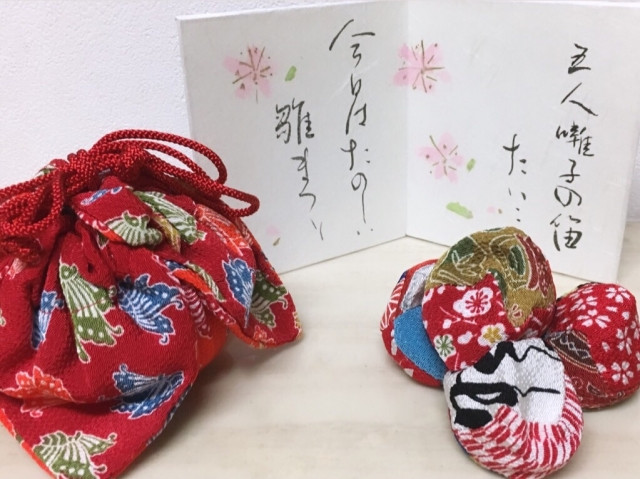
Tanka (短歌) is a form of traditional Japanese poetry that expresses scenes and emotions using 31 syllables in the pattern “5 -7-5 -7 -7”. Tanka has more characters than Haiku and does not include seasonal words. As there are fewer restrictions on writing Tanka, many Tanka poems are about daily life and romance.
Tanka was originally a custom for aristocrats, but as time went by, it became widely popular among the general populace. There are some people who go out of their way to make better Tanka by joining Tanka gatherings to gather opinions or criticism, or through tamei poems based on a specific theme.
If you are studying Japanese and want to achieve a higher level of Japanese language skills, then try your hand at writing a Tanka.
Traditional Japanese Arts: Dentou Sandou (伝統三道)
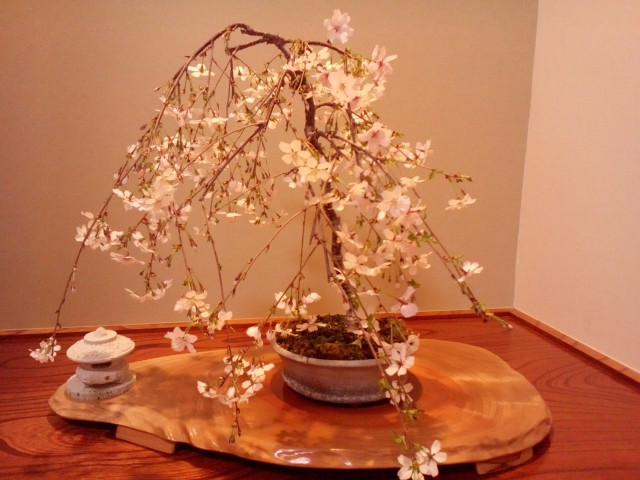
In Japan, tea ceremony, flower arrangement (華道 kadou), and calligraphy (書道 shodou) are collectively known as 「伝統三道 dentou sandou」. In some cases, instead of calligraphy, the Dentou Sandou will have incense burning (香道 koudou) which is enjoyed with waka poems and scenery. In Japan, things that take a long time to master are called 「~~道」.
Tea ceremony (茶道 sadou) was originally a hobby enjoyed by warriors as part of their spiritual training, but nowadays it is more often enjoyed by women.
Flower arrangement (華道 kadou) is also called ikebana (生け花). Flower arrangement is done by arranging plants and flowers in vases to enunciate their beauty and emphasise on the preciousness of life. Kadou is also a traditional culture that is enjoyed mainly by women.
Calligraphy (書道 shodou) uses ink and brush to write characters on Japanese calligraphy paper called “hanshi (半紙)”, and to express oneself with brush strokes. Calligraphy is a traditional culture that is popular with people of all ages, and is believed to cultivate intelligence and sensitivity, as well as for mental unification. Furthermore, compared to the other two traditional arts, calligraphy tends to be enjoyed more by men as a form of learning.
If you are interested in trying any one of these, there are schools offering trial classes or lessons. EDOCCO STUDIO at Kanda Myoujin, Tokyo is one such place where you can experience all 3 and more.
Japanese Martial Arts: Budo

Budo (武道) is martial arts developed in Japan for self-defence and defeating enemies. It is a traditional culture born out of bushido (武士道), which emphasis not only on physical training, but also personal character development and manners.
There are many different types of Japanese martial arts. Judo and Karate, which were competition events in the 2020 Tokyo Olympics, are ones that many people are familiar with. Others include Kendo which is fought with a bamboo sword, and sumo, which is considered Japan’s national sport. Sumo that is fought in a dohyou (土俵; ring) is a spectator sport that really packs a punch. Major sumo tournaments take place 6 times a year at venues such as Kokugikan in Tokyo, the EDION Arena Osaka in Osaka, and the Dolphin’s Arena in Nagoya. Do watch a match whenever you visit Japan.
This is a very brief coverage of Japanese martial arts, so if you want to learn more, check out Budo, Japanese Martial Arts: Introduction to Judo, Kendo, Aikido, Karate and Kyudo (Japanese Archery).
Traditional Japanese Games
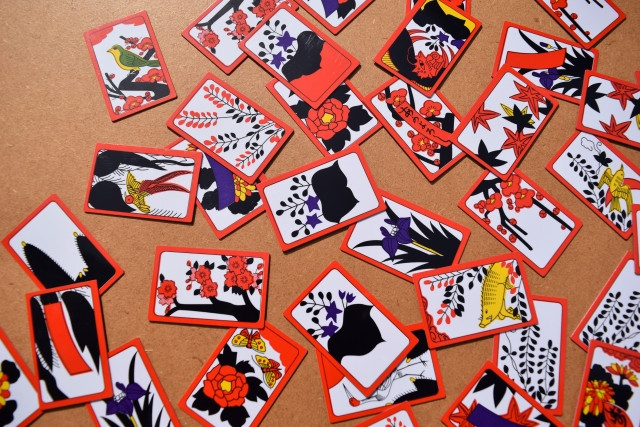
Games that have been handed down through the ages in Japan can also be considered as part of traditional Japanese culture. Spinning tops (独楽 komaraku) and beanbags (お手玉 otedama) are simple games that use simple tools, but are fun and addicting. Karuta (かるた) and race game (すごろく sugoroku) have simple rules so anyone can pick it up easily.
There are also other games such as hanaichimonme (花いちもんめ), bird-in-the-cage (かごめかごめ kagome kagome), and hanafuda (花札).
Japanese Traditional Performing Arts (伝統芸能)
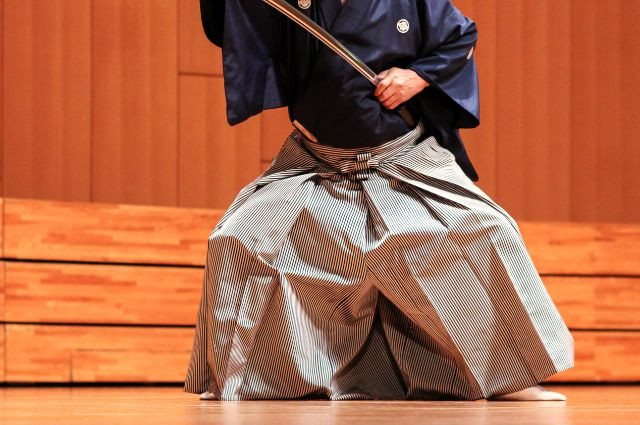
Traditional Japanese culture includes the performing arts. Ini this part, we will introduce the different Japanese cultures that fit in that category including kabuki, noh, buyo, musical instruments, and rakugo. Some of the traditional performing arts were created in different times and eras, and having been passed down to the present day have been designated as intangible cultural heritages.
Kabuki
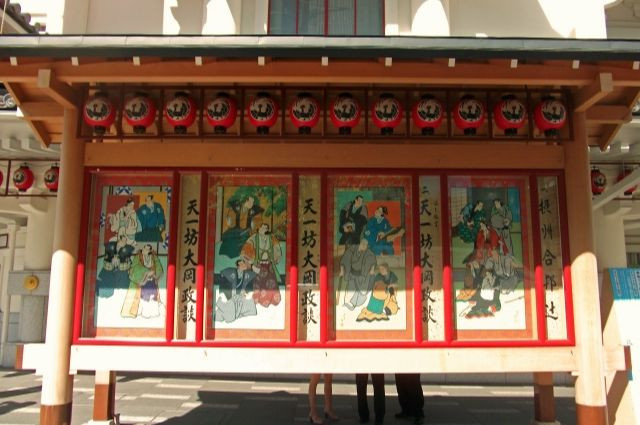
Kabuki (歌舞伎) is one of Japan’s most famous traditional performing arts and is listed as an intangible cultural heritage. A form of theatre, Kabuki was popular in the Edo period as the common people’s favourite pastime. It incorporates the trends of each period and is still widely popular today as a comprehensive art form with elements of dance, dialogue, and music.
Kabuki used to be performed by women and boys, but due to its overwhelming popularity, became limited to male performers only (to protect morality). Therefore, even till this day, female roles are played by men called “onnagata (女方)” who have their own devised makeup, costumes and gestures.
Kabuki can be seen at the Kabuki-za theatre in Tokyo, and other theatres throughout Japan. In addition, the Organization for the Preservation of Kabuki and the Shochikuza theatre have posted Kabuki videos online if you are interested to watch.
Nohgaku
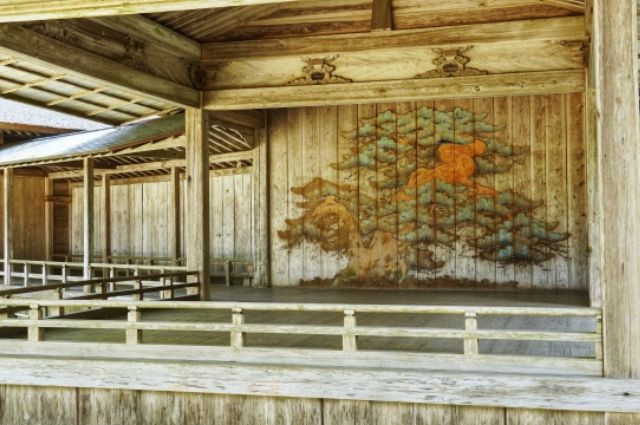
Nohgaku (能楽) is one of Japan's traditional performing arts that has continued since the Muromachi period and is listed as an intangible cultural heritage. Nougaku is a general term for traditional performing arts such as Noh, Kyogen and Shikisanban.
In Noh (能), actors wearing Noh masks perform historical stories accompanied by music called Utai (謡) and Hayashi (囃子). The Noh masks worn by actors vary according to the character they are playing, so there are many types of masks, including female and male masks. Aside from living people, the dead and spirits are sometimes the main characters, and there are stories about searching for someone and duels.
On the other hand, Kyogen (虚言) is a comedy play that makes full use of dialogue and is generally performed without Noh masks. However, when non-human characters appear, then just like in Noh, they will don Noh masks. With stories depicting the fun and hilarity of human beings, Kyogen is said to be a traditional performing art familiar and relatable to people.
Lastly, there is Shiki Sanban (式三番) which is a type of Nohgaku that is performed as a Shinto ritual. Since the performance is to pray for a rich harvest, it is recognised more as a traditional culture than a performing art.
Rakugo
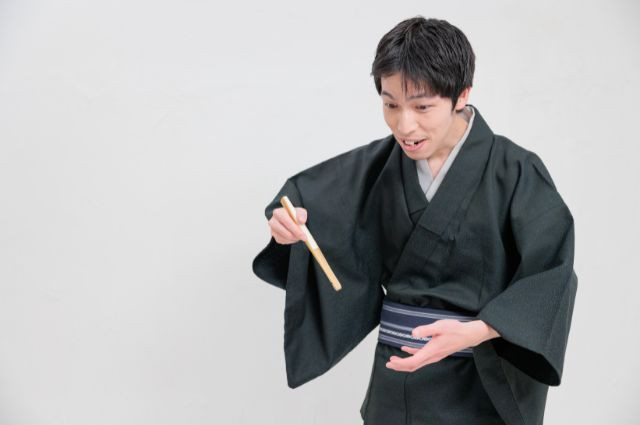
Rakugo (落語) is a type of variety entertainment that is performed in huts that are open to a wide audience, and known as a traditional Japanese performing art. A single person, who is the rakugo performer, called rakugoka (落語家), plays several characters and tells funny and amusing stories to the audience.
The rakugo storyteller wears a kimono and sits on a zabuton (座布団; Japanese flat floor cushion) throughout the performance, telling stories to the audience. The clear ending or punchline to a story is called “ochi (落ち)”, which is why it has been called “rakugo (落語)” since the Meiji era. Rakugo sometimes uses a fan or a zabuton as props to stimulate the audience’s imagination and make the story more interesting. Rakugo can be seen at Asakusa Engei Hall and the National Engei Theatre in Tokyo.
Did you know that you can enjoy Rakugo in English?
Rakugo can be incredibily difficult to understand unless you have a decent level of Japanese proficiency, enough to understand the punchline of the joke, which makes it difficult for many people to get into. Fortunately, the English Rakugo Federation (EFR) with the goal of spreading the Japanese culture of Rakugo to an international audience exists. The Federation is made up of professional Rakugo performers who are fluent in English. They hold Rakugo performances not just in Japan but overseas as well also having occasional apperances on TV, and also offer training workshops for those interested in becoming a Rakugo storyteller! Visit their homepage for event and show announcements, or have a look at their Youtube channel where they post short Rakugo videos.
Gagaku
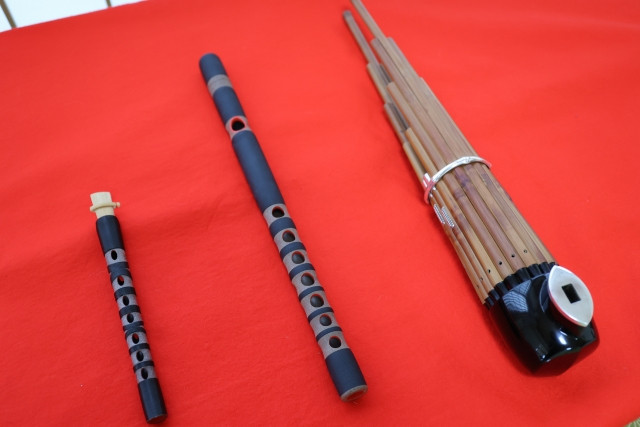
Gagaku (雅楽) is a type of traditional Japanese performing art that is registered as an intangible cultural heritage. Gagaku is the general term for ancient Japanese bugaku (舞楽; court dance and music), foreign bugaku introduced from China and Korea, and Saibara (催馬楽; Heian period court music) & Rouei (朗詠; Japanese or Chinese poem recitation) which originated from the Heian period.
Gagaku is a traditional Japanese performing art that has existed since the Heian and Nara periods, and performed in places like courts, shrines, and temples. At present, Gagaku has been handed down to the Imperial Household Agency, which assists the Emperor and the Imperial Family in their official duties and daily life. They also have private performing groups.
If you would like to hear a musical performance using koto, taiko, dragon flute, and other traditional Japanese musical instruments, then try visiting a shrine or temple event, or a Gagaku concert.
Nihon Buyo (Traditional Japanese Dance)
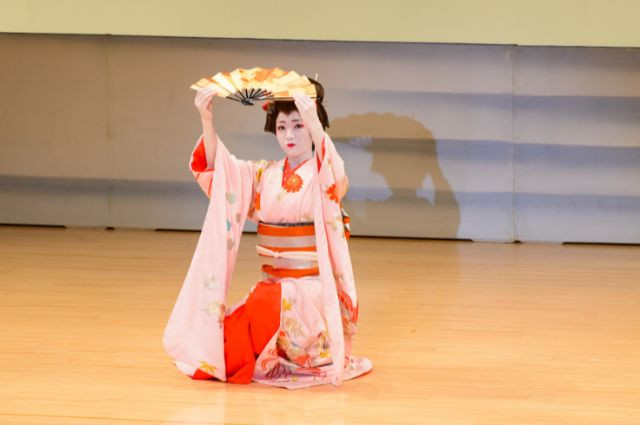
Nihon Buyo (日本舞踊) is one of the traditional Japanese performing arts based on Kabuki dance. Unlike Kabuki, which is performed only by men, Nihon Buyo can be performed by women as well. Since the Meiji era, Nihon Buyo has spread as a form of musical play, but especially among women.
The movements, gestures, and motions of the dancers clad in kimono are beautiful and highly regarded even today. Nihon Buyo is characterised by its dance that imitates natural scenery and the usage of fans as props. In addition, various roles such as young girls, warriors, and foxes are expressed through dance. As a single dancer may perform multiple roles, performing Nihon Buyo requires both expressiveness and technical skills.
Nihon Buyo is also popular as a form of learning. If you study diligently enough, you can become a professional Nihon Buyo dancer. Nihon Buyo performances are held all over Japan, so if you are interested, you should definitely go see one. For those who actually want to try dancing, there are trial lessons you can join.
Different Japanese Cultures in Events and Celebrations
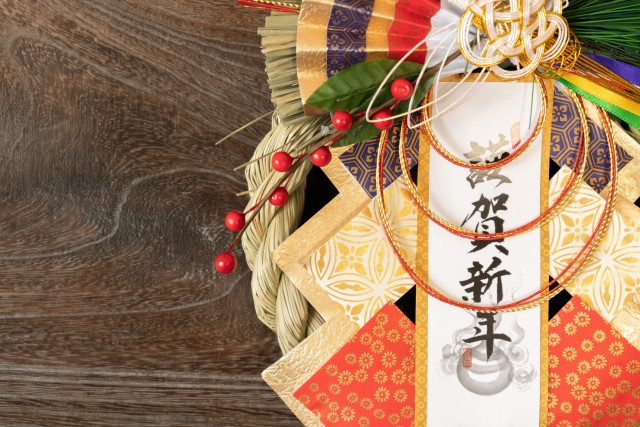
Different Japanese cultures are ingrained in the daily lives of the Japanese, especially for events and festivals. In Japan, many people wear kimonos and eat traditional Japanese food at special events and festivals. Auspicious events are called “Hare no Hi (ハレの日)” and are enjoyed as extraordinary occasions.
For example, New Year is a classic example, people wear kimonos and visit shrines and temples for hatsumode (初詣; first shrine/temple visit of the year). Osechi Ryori (おせち料理) eaten during the New Year is a traditional dish carefully prepared using dashi and soy sauce. They are delicately decorated and made to be colourful to show a sense of Japanese aesthetics.
If you are interested in traditional Japanese culture, it is a good idea to visit when events are happening to participate.
Traditional Japanese Culture is in Decline
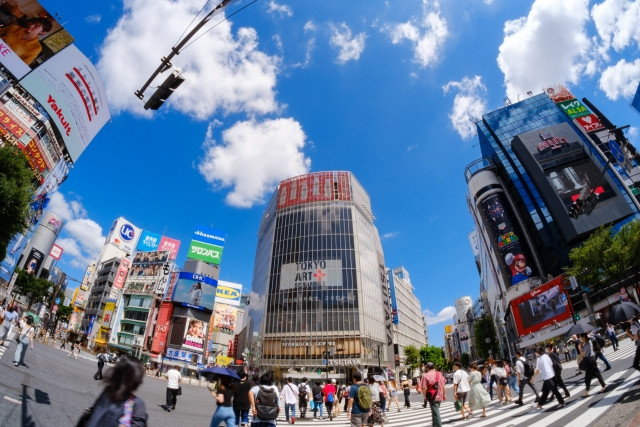
Many of the different traditional Japanese cultures are fading away due to the lack of next generation bearers. Due to the recent rapid development of technology and increase in other forms of entertainment, the demand for traditional Japanese culture and entertainment has dropped significantly. As a result, the number of people who are actively involved and interested in traditional culture and the number of successors to the art is also decreasing, making it difficult to maintain and pass on the culture.
In this part, we will introduce the efforts that are being made, and what you can do to help pass on traditional Japanese culture to future generations. If you are interested in traditional Japanese culture and want to help, please read on.
How Can You Protect Traditional Japanese Cultures
The cooperation of many people is essential to preserve traditional Japanese culture which is in decline. In recent years, TV specials and social media have been actively used to publicise and promote the value and importance of traditional performing arts and traditional crafts.
Worldwide distribution of traditional Japanese performing arts are also done through video websites and multilingual websites so that people abroad can enjoy them too. To protect traditional Japanese culture, it is important to first make people aware of its existence, and then have them experience it.
For those who want to watch Kabuki and Nihon Buyo, or experience traditional Japanese culture in person, your active participation itself is huge in helping to preserve these traditional cultures.
Efforts to Pass on Traditional Japanese Culture to Future Generations
In Japan, the government and local authorities are taking the initiative to introduce various initiatives to preserve traditional culture and pass it on to future generations.
For example, the Agency for Cultural Affairs is implementing a project called “Traditional Culture Parent-Child Classroom Project (伝統文化親子教室)”. The aim is to provide children, who are leaders in our future, with opportunities to experience and learn traditional culture, and to nurture successors. Under the project, participants can experience activities related to traditional culture, such as tea ceremony, flower arrangement, etc. throughout Japan.
In addition, Youtube channels have also been set up to promote traditional culture. Meanwhile, local authorities seem to be using traditional culture to revitalise their towns. It is a win-win situation, both to make people aware of traditional culture and to develop the local area. In fact, Izushi-cho in Hyogo Prefecture and Yamaga City in Kumamoto Prefecture are using Japanese architecture to revitalise their towns.
Experience Traditional Culture When Visiting Japan
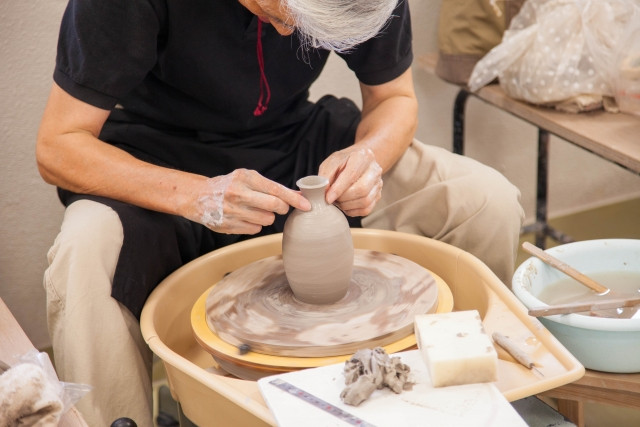
We hope you enjoyed your tour of the different traditional Japanese cultures there are. Traditional Japanese culture is famous not only in Japan, which is why it is sad that despite many people’s interest in it the demand is still decreasing and there is danger of not being able to pass on traditional cultures.
In order for traditional Japanese culture to continue to be passed down through the generations, it is important for many people to become aware of its charm and importance, and to actively experience it. Be it kimono, Japanese food, or kabuki that truly represent Japan, do give them a try when visiting Japan for travel, work or study abroad, and spread the word to friends and family!











 (2).png)
























